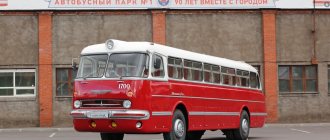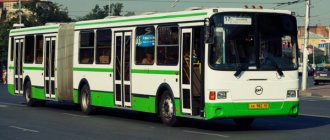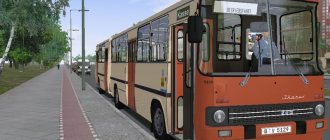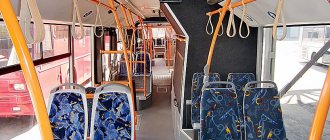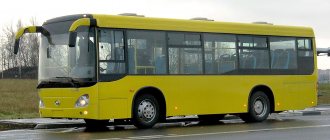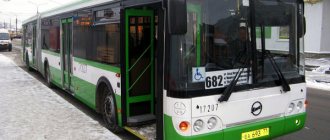The growing Soviet state at one time was in dire need of roomy and comfortable buses. Citizens did not have many personal vehicles, and therefore intercity travel was considered quite problematic. The Hungarian Ikarus plant volunteered to help, where they began producing the legendary Ikarus 250.
It should be noted that their production did not start out of nowhere, since back in the late 1960s the concept of 200 series buses was developed, which were the forefront of road transportation for their time. The main idea that predetermined the popularity of the Ikarus 250 bus was modularity and high unification, which made it possible to quickly and inexpensively introduce new models into production. Simplification of the design made it possible to put a new bus on the stocks already in the early 70s of the last century.
Living legend of Soviet routes
The Ikarus 250 model was in production from 1971 to 2003! Over 32 years! It is believed that during this time, about 150 thousand cars left the walls of the plant. Initially, this bus was widely imported to the “fraternal” republics to organize intercity traffic, but soon, due to the accelerated growth of cities, the cars began to be used exclusively on domestic routes. Due to their capacity and comfort, these Ikaruses were greatly loved by various tourism organizations, which used them to organize excursions.
In the southern republics, it is still practiced to remove all passenger seats in the cabin and then turn the Ikarus into a huge truck. True, for its normal operation it is necessary to sort out and re-weld the entire suspension, since the old one simply cannot cope with the increased loads. However, this situation is typical not only for our country: Ikarus 250 is found even in the USA and Latin America. Of course, most of the buses of this series are now in such a poor technical condition that their operation is purely periodic.
If you look closely, traces of the original license plate can be read on the stern: 6600 SSP
0
Source:
By 2010, Ikarus was retiring at the resort: the sanatorium was given a new car, and the old one was put up for sale. A private owner from Vladikavkaz became the new owner of Apollo. He also provided the Ikarus with a simple Soviet-style tuning, and slightly modified it for his convenience. Mainly in Ossetia, Ikarus worked on all kinds of orders - but in the low season, when there were few applications, the owner also used this car for intercity work. So another ten years passed.
Basic information about the model
Oddly enough, even painting the body red with a white line along the bottom was once regulated by a separate GOST. The new model differed from its predecessors not only in this, but also in its significantly longer body. There are five extended windows on each side, which (in recent years) could be tinted at the request of the customer. The vents are located through the window; there are quite massive air intakes on the roof, one of which can be used as an escape hatch. It is worth considering that the Ikarus 250 bus initially differed from its urban “brothers” by four round headlights (two on each side). Some varieties had a spotlight installed on the roof.
The latest modifications are distinguished by the presence of two fully glazed doors. The first was equipped with a pneumatic drive, activated by pressing a button on the panel. The door moved parallel to the side. It’s interesting, but on some buses there was no pneumatic drive initially, and therefore it had to be opened and closed manually. The second door is located in the “aft” compartment, opens and closes using a manual lever.
General impression
This model is presented as a high-floor, large-class bus for intercity transportation. The body has a classic carriage layout; the frame is a metal frame made of square pipes.
In terms of reliability and durability, the 250 has become one of the best and has not lost its position to this day. Over many years of use, the body has not lost its original characteristics.
Of course, there is no escape from corrosion, but in general the geometry is unchanged, with the exception of some instances with a hanging rear platform. This is explained by the specific location of the engine in the rear.
The glass area is impressive. Already at that time, rubber seals were used, and on the “T” series modifications, glass was glued into the body (by the way, modern MAZ buses have only now begun to do this). In total, the 250th had three body color options:
- the lower and upper parts are white, the sides are red;
- the top and sides are white, the skirt is burgundy;
- the skirt is blue, the top is cream, and the side is dark blue.
Later versions produced after the early 90s had a red bottom, cream top and red stripe along the sides.
The head optics had only 4 blocks with halogen lighting. The bumpers are metal (later versions had plastic ones, but not from the models) and are rigidly attached to the body. Moreover, depending on the marking, the front bumper could be equipped with fog lights.
A separate story: the front door drive. It is electro-pneumatic, which was a luxury in those days. Soviet technology never dreamed of this. To open, just press the button on the control panel.
The rear door was equipped with a mechanical drive (special lever). However, some models had remote control of the rear door.
About the salon
Of course, the Ikarus 250 bus is not equipped with an interior that can at least to some extent be called modern, but it still has no serious shortcomings. It can accommodate from 43 to 57 paired seats with wooden armrests, and the distance between the seats is very small, only 65 cm. The seats are quite hard and have not proven themselves well on long flights. But each pair of chairs has individual air ducts and small lamps, which was something “cosmic” for the 70s in the USSR.
Rolls-Royce among buses
Maxim Shelepenkov Photo by the author, Alexander Novikov
At the International Bus Week in Nice in May 1969, the Ikarus 250 was awarded the silver cup of the Federation of French Bus Body Manufacturers. Two years later, the luxury Ikarus 250 won the Grand Prix at the Monaco Bus Week, established by Prince Rainier of Monaco. After this, the French magazine L'EXPRESS called the Ikarus 250 with its kitchen, toilet, air conditioning and sixteen swivel seats with speakers built into the headrests the “Rolls-Royce” of buses.
The large 12-meter intercity bus Ikarus 250 is rightfully considered the flagship of the entire “200th” Ikarus family. The first prototype of the “250th” model was assembled on May 1, 1967 and was shown at the Budapest International Fair in company with the chassis of the “282nd” model articulated bus.
The new Ikarus family, including the flagship vehicle, attracted interest in the Soviet Union, which was experiencing an acute shortage of buses, including for intercity transportation. It is not surprising that the second experimental Ikarus 250, assembled in the same year, was sent for interdepartmental tests in the USSR, which were carried out from January to August 1968. During this time, the dark green bus with a white skirt covered more than 40 thousand kilometers across the USSR.
At first, Ikarus 250 was assembled in small batches, so their deliveries to our country amounted to only a few. Unlike the prototypes, the production Ikarus have changed slightly in appearance: the rectangular headlights were replaced with double round ones, the central vertical bars were removed from the side windows, the wheel arches received smoother contours, etc.
The early Ikarus 250 came to the Soviet Union in two main configurations: the luxury Ikarus 250.10 had 45 seats in the cabin (including a seat for a guide), a buffet bar and a wardrobe for storing passengers' outerwear; The budget Ikarus 250.09 was deprived of additional equipment, but due to this, the number of seats increased to 57.
Since 1976, buses in a new configuration - Ikarus 250.12 - began to be supplied to the country. Unlike previous cars, the radiator of the engine cooling system was moved back to the engine compartment (previously the radiator was located under the front bumper, which is clearly visible in old photographs). The engine on the bus remained the same, but a new 5-speed gearbox was installed - ASH 75.1-A7.B1.C3.D2.E1.
The following year, 1977, the flagship car underwent a slight restyling - one of the noticeable external signs was a new black plastic bumper at the front.
The bus index has changed to Ikarus 250.22 Deliveries of Ikarus 250 buses to the USSR
| 1968 | 5 | 1983 | 1020 |
| 1969 | 3 | 1984 | 1433 |
| 1970 | 50 | 1985 | 1151 |
| 1971 | 300 | 1986 | 1252 |
| 1972 | 704 | 1987 | 944 |
| 1973 | 501 | 1988 | 1258 |
| 1974 | 501 | 1989 | 751 |
| 1975 | 602 | 1990 | 886 |
| 1976 | 502 | 1991 | 61 |
| 1977 | 501 | 1992 | 131 |
| 1978 | 500 | 1993 | 122 |
| 1979 | 500 | 1994 | 10 |
| 1980 | 500 | 1995 | 2 |
| 1981 | 799 | Total: | 15 870 |
| 1982 | 881 |
Since 1980, Ikarus 250.58 began to arrive in the USSR, which even in appearance were very different from the buses that came before. The new cars received a slider-type front door with an additional window in the lower part, which can now be opened remotely from the driver’s seat. An additional entrance door appeared at the back, still opened manually in the old fashioned way. In the cabin, due to the appearance of an additional entrance area at the rear, the number of seats was reduced to 43 (including the guide), and the buses themselves, instead of the usual red color, received a central stripe of bright scarlet color.
The aggregate part has also changed again. The Ikarus 250.58 began to be equipped with a more powerful turbocharged Raba-MAN D2156HM6UT engine with a power of 220 hp. and a 6-speed gearbox. The front axle received a new anti-roll bar. In this form, flagship buses were delivered to our country until 1983 inclusive.
Since 1989, a series of new versions have come: Ikarus 250.93 (with increased seating to 51 and without a household unit in the cabin) and Ikarus 250.95 (with a preserved cabin layout for long-distance intercity routes). The units remained the same, and externally the buses of the new configurations could be distinguished by the reduced size of the side window of the driver's cabin and a changed paint scheme: most often they were now painted ivory with a red “skirt” and three longitudinal red stripes along the sides.
The Soviet Union, along with East Germany, were the main customers of the Ikarus 250. The share of imports of the Ikarus 250 for the entire period of its production amounted to about 90% for the USSR of the total number of vehicles produced. Hungary occupied only third place among the customer countries of the flagship model. A noteworthy fact is that the 20,000th and 50,000th buses produced for the USSR in 1973 and 1978, respectively, were vehicles of the “250th” model.
Three lampshades with eight lamps each provide general lighting for the interior. Heating – radiators installed under each pair of seats; the engine cooling system is responsible for heating the liquid. The bus is notable for the fact that its floor is significantly lower than the level of the seats. This not only made it possible to significantly expand the luggage compartment, but also completely isolate the “bulges” from the wheels. However, it is the design of the cabin that makes the Ikarus 250/40 (and its other varieties) practically unsuitable for city use, since passengers who often have to get in and out find it extremely uncomfortable in a narrow aisle.
In normal configurations, blinds were mounted on the windows, which were very convenient on long flights during the day, when the sun could prevent people from taking a nap. The front part of the cabin is distinguished by the presence of an additional folding seat, which is used by guides, controllers, or an additional driver sits there. In the export versions of the Ikarus 250/40 (photos of the bus are presented in the article), a special room with a toilet and a small refrigerator was installed at the end of the building. Unfortunately, in the European part of the USSR this variety was no more common than some kind of Cadillac. Additional five seats were placed in the rear of the cabin, although it was extremely bad to ride in them due to the strong vibration of the engine and the heat from it.
Magnificent "wanderer" - "Ikarus-256"
The Ikarus-256 model was produced for half a century, which first came off the assembly line in 1977. It was a slightly improved Ikarus-250 - more comfortable and a meter shorter (length 11 meters). The capacity of the Ikarus bus was designed to transport tourists, including foreign ones, and it had 45 soft seats. The last five seats are combined into a “sleeping” sofa, which is slightly raised (two steps) above the rest of the bus interior. An undoubted innovation for that time was the presence of a TV mounted to the right of the driver. In contrast to all this splendor were the luggage racks that this model inherited from the Ikarus-255 (fabric mesh on the frame).
The design remained unchanged. The body is monocoque, carriage type, the engine is rear-mounted and more powerful than on previous models (250 l/s). The luggage compartment has become significantly larger. The location of the company logo and the number 256 is above the air intake. There was a panoramic, two-part, huge windshield, rear-view mirrors of the “hare ears” type and powerful two pairs of headlights with lens coating.
Driver's seat
Steering – type ZF S6-90U. The driver's seat is practically no different in style and functionality from the passenger seat. The only caveat is the height adjustment. The driver's workplace is not separated from the passenger compartment in any way, except for a small glass wall. The instrument panel is characterized by its large size and good readability of all sensors: speedometer, tachometer, voltmeter, and fuel level indicator.
Body
Assembled from square pipes, carriage type. The designers envisaged a service life of at least three decades. Unfortunately, such a design entails unpleasant consequences. If the bus was operated in difficult climatic conditions without major repairs, then the sections of the body in its rear part literally sagged, severely deforming the interior. On the sides there are two large luggage compartments (one on each side), each with a volume of 5.3 m3. There are two ways to open the compartments: either using a hand lever directly on the body, or using a button on the dashboard.
The rear bumper on the Ikarus 250 bus (you will see the photo in this material) is metal, attached to the body using welded fasteners. The first buses in the series had almost exactly the same bumper installed on the front, differing in some minor details. Due to the practical structural uselessness of metal, plastic structures were subsequently installed, which made it possible to somewhat reduce the cost of the structure.
History of Ikarus
I wonder if the founder of the blacksmith shop, Imre Uri, who planned to repair carriages, could have imagined that just under 100 years after its founding, by 1984, his company would produce the 200,000th Ikarus bus? No, i guess. But the company did not receive its famous name immediately, but only in 1948, when the T. O. O. Uri Brothers, which at that time already belonged to the sons of the founder, merged with the Ikarus Joint Stock Company for the production of machines and metals, as a result of which a plant appeared with a name familiar to you, received in honor of the mythical character Icarus.
The Uri brothers had experience in producing buses, they didn’t have to wait long, and three years after the merger, in October 1951, the joint venture produced the first thousand Ikarus. In 1962, a merger took place with the General Mechanical Plant in Székesfehérvár, which made it possible to establish large-scale production of buses for the own needs of Hungary and abroad. It was planned to assemble up to 10,000 Ikarus buses a year, but in the best years of the plant, up to 12,000 buses rolled off the assembly lines.
From left to right: MAVAG Tr5, Ikarus 311, Ikarus 630, Ikarus 55, Ikarus 180
Hungarian buses were in demand in the USSR - the Soviet Union was among the largest importers of Ikarus. In the historical reference books “Foreign Trade of the USSR” you can find information on supplies and average prices for this equipment for the period 1966 - 1990:
| Year | 1966 | 1967 | 1968 | 1969 | 1970 | 1971 | 1974 |
| Things | 804 | 1021 | 1556 | 1894 | 2865 | 3004 | 5153 |
| Thousand rub. | 9373 | 13610 | 22694 | 30801 | 56269 | 61307 | 110069 |
| Rub. per unit | 11658 | 13330 | 14585 | 16262 | 19640 | 20408 | 21360 |
| Year | 1975 | 1986 | 1987 | 1988 | 1989 | 1990 |
| Things | 6169 | 7792 | 7942 | 7378 | 6103 | 6085 |
| Thousand rub. | 165402 | 475902 | 538574 | 506387 | 424732 | 456270 |
| Rub. per unit | 26812 | 61076 | 67813 | 68635 | 69594 | 74983 |
Demand for Hungarian buses with the Ikarus badge grew in the USSR until 1987, reaching a peak of 7,942 units, then began to gradually decline. With the collapse of the Soviet Union and the Council for Mutual Economic Assistance, the Hungarian plant lost its markets. There was no second attempt - almost immediately the enterprise was divided and one after another the production sites in Budapest and Székesfehérvár were closed. Only the EAG enterprise remained afloat - the heir to the pre-war company - which until 2003 produced buses according to special orders on imported chassis. In 2007, it declared bankruptcy.
However, the legacy of its former glory can be seen live now, not only in museums, but also on the go. Hungarian photographer Adam Vellai, who prefers to photograph buses, has collected an impressive collection of photographs of various equipment on his page on the Flickr social network. The local Ikarus are especially close to the photographer, and we decided to select the best of the photographs and remember what kind of equipment they were.
About engines
Most often, the Ikarus 250 engine is the infamous Raba-MAN D2156HM6U among drivers; there are also cars equipped with Raba D10 and D11. They were in-line, had six cylinders, and were turbocharged. Their power varied, the most advanced modifications produced up to 220 hp. With. In recent years, Raba-MAN D2156HM6 diesel has been installed on buses. The power of these engines was slightly higher, but their main characteristics remained the same. A common drawback of the engines is poor power and even worse low-end thrust. These factors cause both poor acceleration and extremely negative performance when driving uphill.
Many people remember how the Ikarus took almost hours to storm those climbs that even MAZs with completely “dead” engines could cope with. However, in a straight line, these diesel engines could easily provide a constant speed of 100 km/h, which was a very good result for Soviet buses.
Detailed description, device, design features
body is load-bearing, carriage-type, welded from square pipes. As practice shows, the service life of the body is about 30 years; in buses of the first editions (Mod. .00-.09\.12-.17\.22\.44\.58) the body bends in an arc over many years of operation, in later ones On buses, starting with modification .59, sometimes the rear overhang begins to sag. However, body deformations and destruction of power structures are observed only in buses that have been in operation for a very long time without proper major repairs.
Bus Ikarus 250, general view. Photo Wikipedia
There are luggage compartments on the sides ; the volume of one of the two compartments is 5.3 cubic meters. (total - 10.6). These compartments are opened either manually using a special handle, or with a button on the instrument panel .
The bus has a sufficient glass area ; all windows are held on by rubber seals, although in the 250.T modification the side windows were glued in. The front lighting of all modifications of the 250 model (with the exception of some modifications for the Hungarian market) consists of four round headlights , two on the left and two on the right side. During operation, instead of a standard front mask, a similar one, but with only two headlights, from the 260 model can be installed, or instead of factory headlights, others can be installed, most often from VAZ 2105\2107 cars. The rear lighting consists of three headlights on the left and right sides. Sometimes during operation the rear lighting equipment is also replaced.
The rear bumper of all modifications is steel, welded, and is attached to the body with screws. The front bumper of early modifications (up to .58) is similar in design to the rear. Sometimes holes were stamped in the bumper for installing fog lights. Starting with modification .58, a front plastic bumper was installed.
Buses supplied to the USSR were painted according to one of the standard schemes:
- Dark red skirt, white sides and top (before 1980)
- White skirt, dark red sides and top (until 1980)
- White skirt, light scarlet sides, white top (until 1984)
- White skirt, light scarlet sides and top (since 1980)
- Blue skirt, cream sides and top, dark blue stripe along the side (since 1988)
- Light red skirt, cream sides and top, light red stripe along the side (since 1990)
Engines. Most modifications were equipped with a 6-cylinder diesel engine RABA-MAN D2156HM6U , volume 10.3 liters, power 192 hp. and torque 696 Nm. The .58 modification was equipped with a RABA-MAN D2156HM6UT with increased power.
Despite the fact that the D2156 series engines have good dynamics, maintainability, reliability and simplicity, at the same time they have a number of disadvantages (insufficient power and torque), the most noticeable of which is their short resource: due to insufficient power, the engine runs more often at high speeds, which also significantly affects the resource.
Bus Ikarus 250, rear view. Photo Wikipedia
In terms of noise level, the engine is not particularly noisy, but during operation (muffler burnout, improper operation of the engine, or operation with a malfunction), the noise level increases significantly and also begins to smoke very much. Due to insufficient power and traction, the bus accelerates much slower than other buses of its kind. However, the engine of this model allows the bus to move at a constant speed of 100 km/h. Buses of later releases, modifications .93/.95, were equipped with RABA D10 and D11 series . Buses equipped with engines of these series do not have such problems with dynamics due to the fact that the power and thrust of these engines are noticeably higher.
There are also modifications with the RABA-MAN D2356HMN6 and Detroit Diesel/Cummins VT350/DAF LT120 engines.
Vehicle fleets, not having the funds to replace a new engine, installed the famous domestic YaMZ-236/238 + YaMZ gearbox or KAMAZ-740 + KAMAZ gearbox. When installing the YaMZ engine, it was necessary to reshape the rear engine compartment, because it is larger than RABA-MAN. Because of this, a podium appeared in the rear of the cabin.
Doors. The bus has 2 doors - the first, with an electric pneumatic drive (starting from modification 250.58), opens and closes using a button on the instrument panel and moves parallel to the side. On early modifications, the swing door was opened manually . The rear door is located in the rear in front of the very last row of seats and is opened manually by pressing a lever ; in early versions there was no second door. But modifications were also made where both doors opened automatically.
Although the interior it does not have any particular drawbacks. The cabin has 43-57 paired high-back seats, but the distance between the seats is small - about 65 centimeters between the seats, on which wooden armrests are installed. The seats are hard and relatively uncomfortable.
The interior is equipped with ceiling-type lamps with 8 lamps ; instead of a forced air hatch, there are 3 hatches. Heating is carried out through radiators under the seats. There are 5 seats at the end of the cabin, and this part of the cabin is the noisiest and hottest due to the operation of the powerful Rába-D2156HM6U (T) diesel engine. The chairs can recline slightly using a button on the armrests, approximately 100-110°.
The driver's seat is made in the same style as the passenger seats. The instrument panel contains a speedometer (quite simple, the maximum mark is 120 km/h), a tachometer (2.8 thousand rpm) and several auxiliary instruments (voltmeter, fuel level indicator), which are not equipped with backlighting. Steering ZF S6-90U; six-speed gearbox. The speedometer is combined with the odometer. It can be replaced by a similar speedometer model used on the ROCAR DAC bus and ROCAR E187 trolleybus models. The tachometer is located on the left side of the panel.
There is no special door for the driver ; there is no partition separating the cabin from the cabin.
A spare folding seat for a guide or a second driver is placed near the driver
The windows are solid, separate , surrounded by a special rubber frame. The bus is equipped with five windows on each side; the windows are usually not tinted, although they can be darkened upon request. Sun curtains are often chosen to be red and offer little protection from the heat.
Modifications: 250.59 and others
Bus Ikarus 250.59. Photo Wikipedia
The Ikarus 250 bus had several modifications that had slight differences in the body, engine or cladding:
- Ikarus 250.04, Ikarus 250.09 and Ikarus 250.12 - these were the very first models imported to the USSR. Such cars had only one door, an engine power of 192 horsepower, an engine capacity of 10.4 liters and a maximum speed of 97 km/h.
- Ikarus 250.22 - the bus was produced from 1977 to 1980. One of the main external differences received a wide plastic bumper for the first time.
- Ikarus 250.58 is a new modification of the Ikarus-250, produced since 1980. It received a six-speed gearbox, a boosted engine with 220 horsepower, a top speed of 113 km/h, an automatic front door and a second one that opens manually. On late-production cars, a glass hatch appeared on the bottom of the front door.
- Ikarus 250.59 is one of the most widespread and surviving modifications of the Ikarus 250, produced since 1984. The main external difference from the previous modification is 6 narrower windows on the left side after the driver's window and 5 on the right between the doors. The previous modification had 5 wide windows on the left and 4 on the starboard sides. Cars of this modification could have two automatic doors.
- Ikarus 250.93; Ikarus 250.95 - updated and improved models of the Ikarus 250, which were produced in the early 1990s. Cars of this modification could have two automatic doors.
Disadvantages and advantages of Raba D10 (D11)
The main disadvantages are still the same - dynamics and acceleration, although these engines still show much better results. But they were equipped with higher quality parts, which ensured quite acceptable reliability, durability and maintainability of the motor. But the weak dynamics, coupled with the winding roads with frequent climbs common throughout most of the USSR, negated all the advantages, quickly devouring the resource. When engines wear out, they begin to vibrate very strongly and smoke. In addition, “Slaves” were notorious among Soviet drivers, as they consumed oil on a cosmic scale. The real dream of drivers was the Detroit DieselCummins VT350DAF LT120 engine, which was devoid of almost all the shortcomings of the “Slave”, was more economical and more powerful, but was practically not found in cars mass-produced in the USSR.
Characteristics of the braking system
The Ikarus 250 bus, the technical characteristics of which we are considering, was equipped with a dual-circuit drum brake mechanism. The brakes were operated using a pneumatic drive. The brake drums had a radius of 21 cm, their thickness was 14 and 18 cm, respectively. When driving at a maximum speed for a populated area of 60 km/h, the braking distance was up to 37 meters. The parking brakes on the rear wheels are mechanical spring brakes with a pneumatic drive. There is an auxiliary brake drive, the functions of which duplicated the parking one. Compression in the system drives is from 6.2 to 7.4 kgf/cm2. To prevent the condensation formed there from blocking the operation of the brakes in winter, a special liquid based on technical alcohol is used.
Revival of Ikarus in 2022
In 2022, it became known that the Hungarian tycoon Gabor Szeles. founded the company Ikarus Jarmutechnika Kft. and presented the first bus of the revived Ikarus brand - model 125 on the Volvo B8RLE chassis. It can already be sold in the European Union, since a certificate of conformity has been received. This is not the first attempt to revive Ikarus; previous ones ended in failure.
Revived Ikarus 125
The new Ikarus is powered by a 7.7-liter six-cylinder turbodiesel engine producing 320 hp. In addition to “heavy fuel,” this engine can consume hydrogenated vegetable oil and methyl ester of rapeseed oil. Time will tell whether the revived Ikarus will be successful.
Other characteristics
High beam lighting fixtures are equipped with 45 W lamps, and 40 W lamps are used for low beam.
The side lights are equipped with 5 W Villtes series bulbs. If there are any malfunctions in the engine cooling system or a drop in compression is noted in the brake system hoses, a red light immediately lights up on the instrument panel. A separate indicator also signals when the batteries are low. The bus is convenient for repairs because all electrical fuses are located right on the driver’s seat, in the form of one block. In principle, the Ikarus 250 bus (a photo of which you will see in the article) had a good reputation among passengers, who were most dissatisfied only with the insufficient operation of the heater in winter. Other factors did not significantly reduce travel comfort. An interior that was advanced for those times and soft seats, a reliable suspension and a normal ventilation system - these were the factors that made it possible to travel long distances with relative comfort. It is not surprising that in some places the Ikarus 250/59 is still in use.
Modular design
The Ikarus-280 bus replaced the Ikarus-180, which had already exhausted its service life. The main idea of this model was its modular design, so it had more than fifty modifications. It was possible to change everything in it - from the length of the bus itself (maximum 18 meters), the number of doors (from one to four) to almost any brand of engine and type of transmission.
In outline it was already a regular parallelepiped with a rounded frontal view. The engine produced 190 l/s, was located under the floor, and had a service life of half a million kilometers before major repairs. Large areas accommodated more than one and a half hundred passengers, with 35 seats. The floor was covered with a rubber carpet. Smooth running (a distinctive feature of the Ikarus-280) was achieved by a large number of air cylinders. The drum brakes are equipped with a pneumatic drive.
What technical characteristics does the Ikarus bus have:
What does the Ikarus bus look like? The reader can see his photo in our article.
